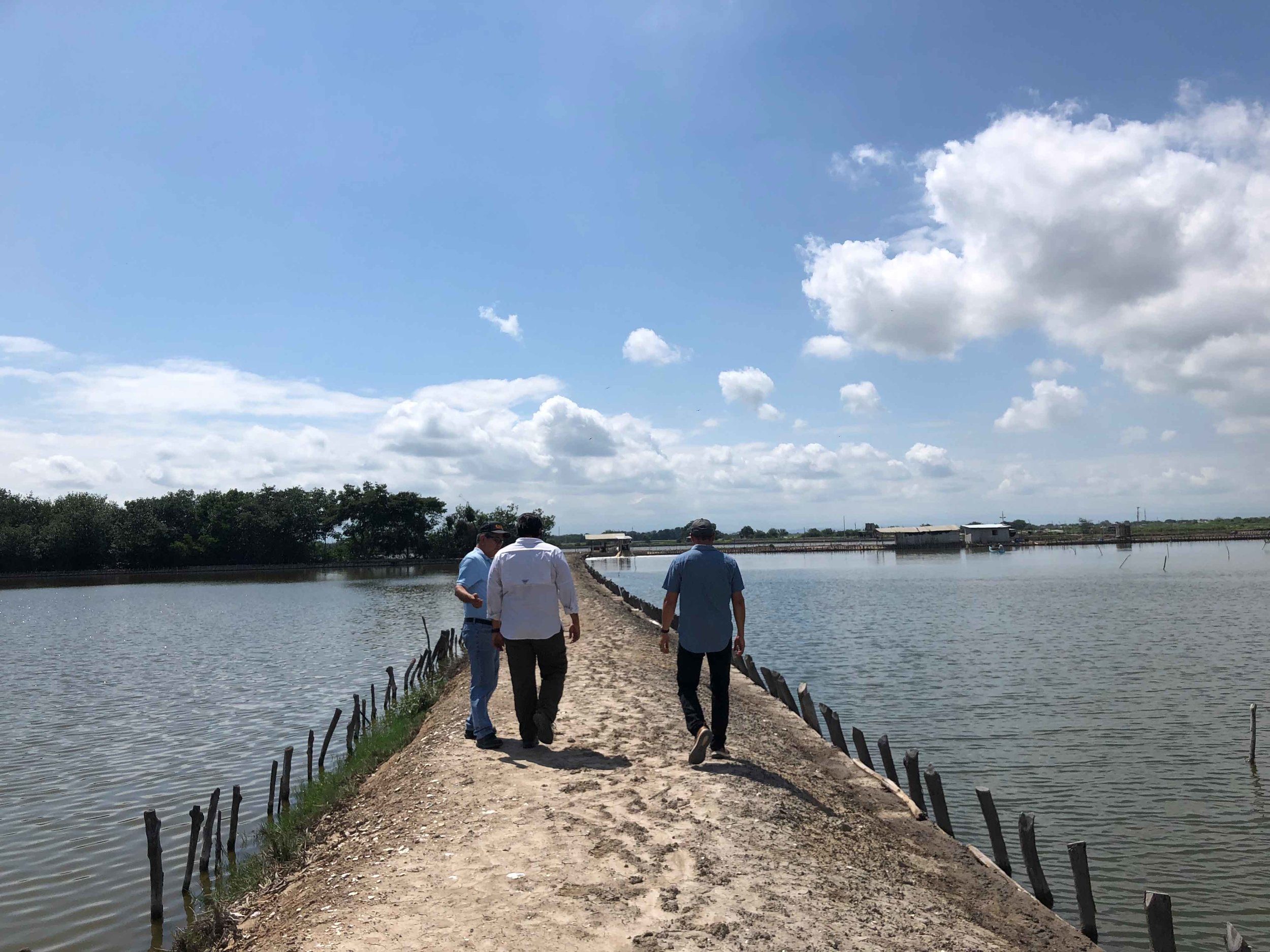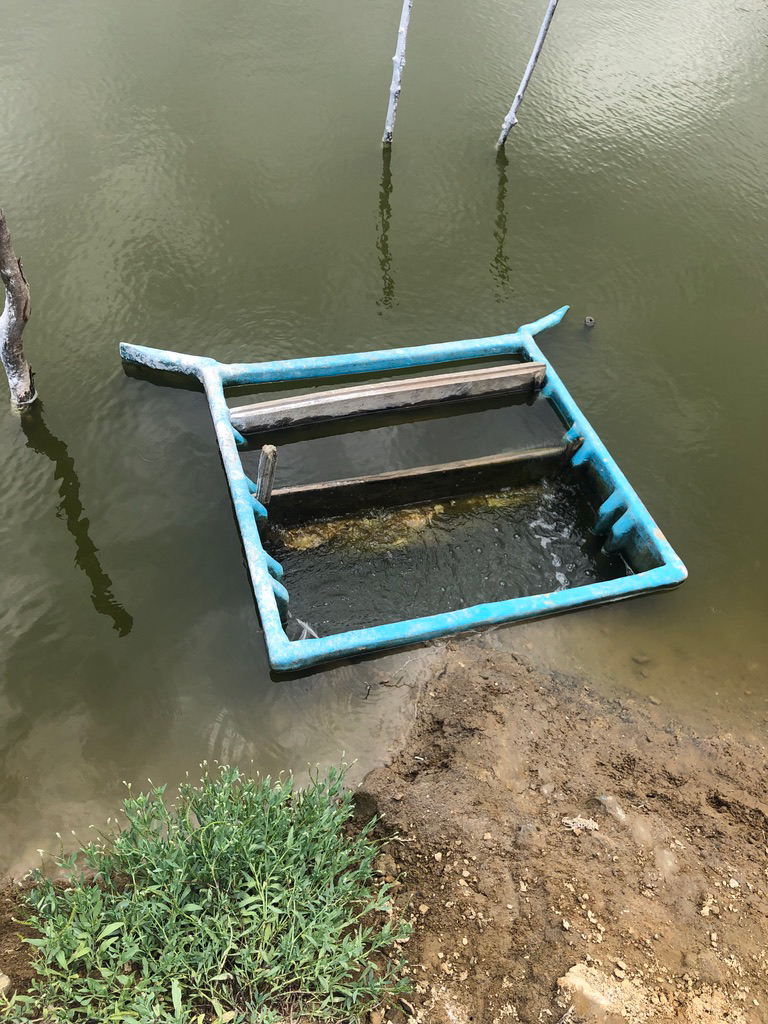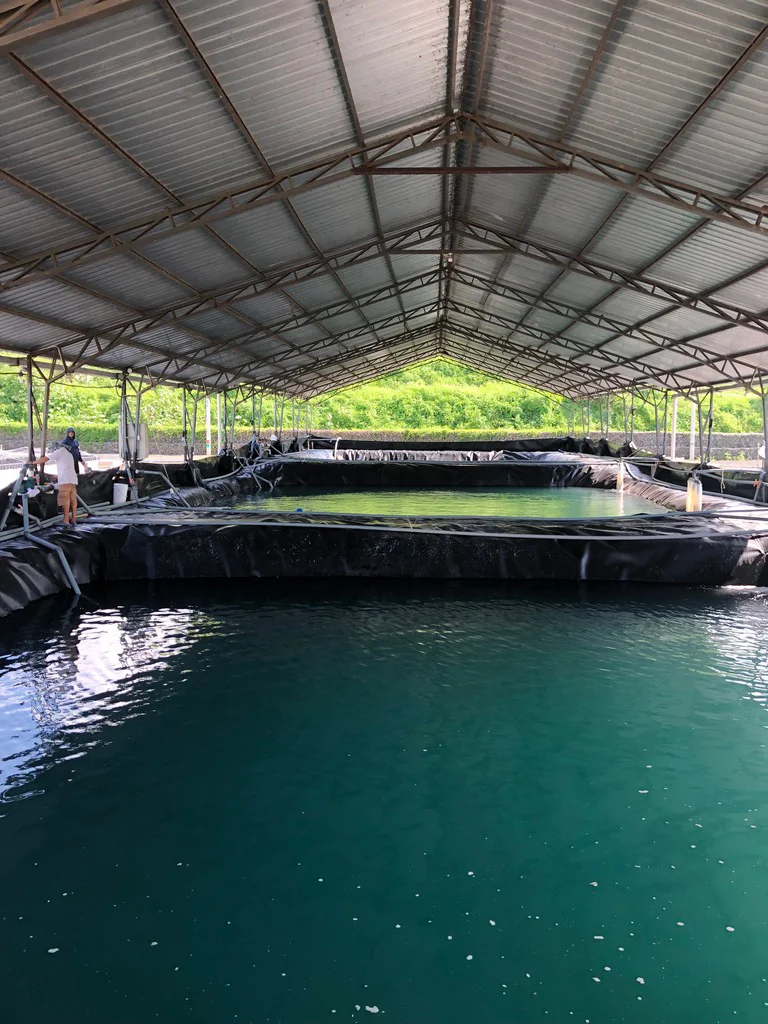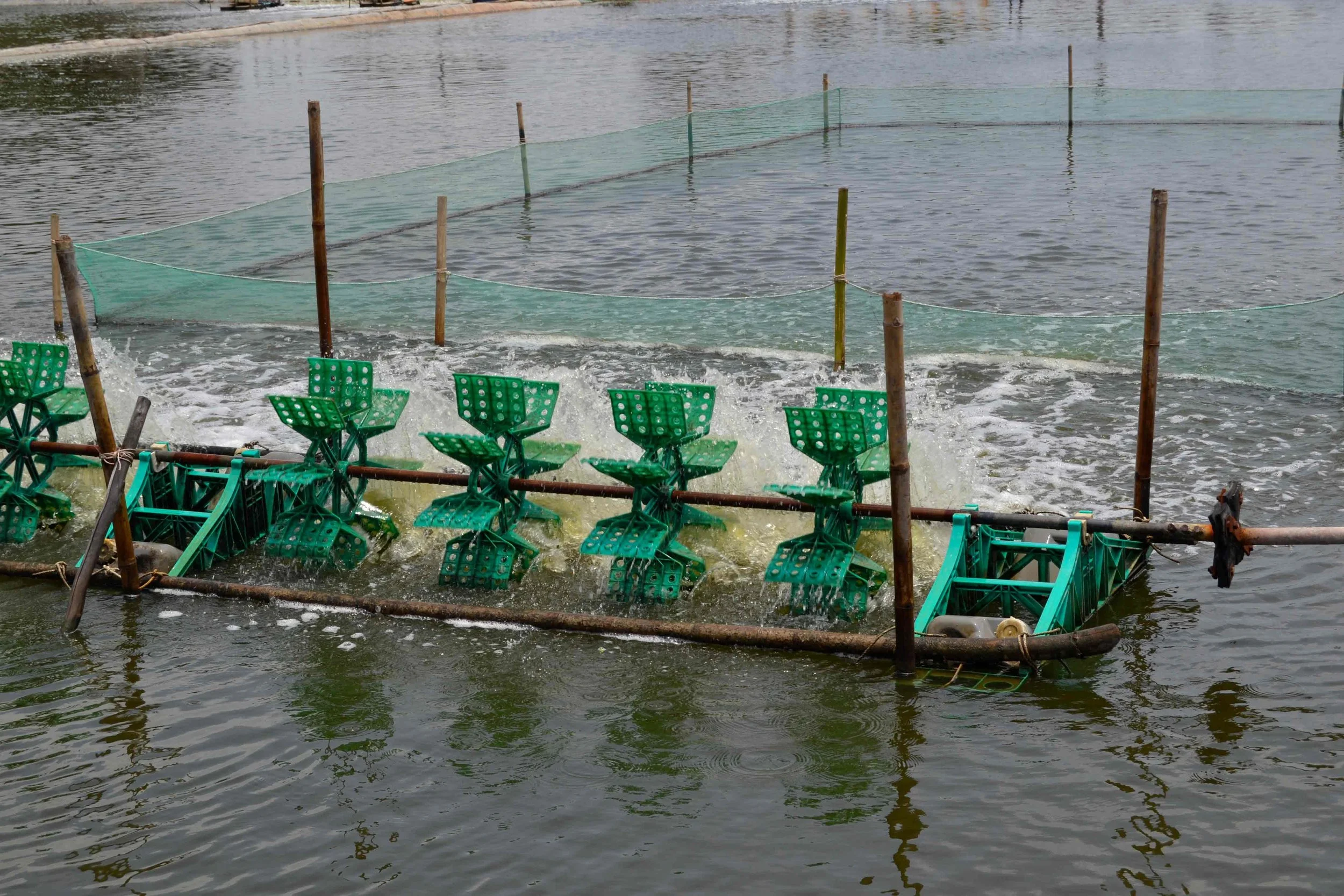INfrastruCture
While infrastructure varies widely by region, location and farm size, there are a few commonalities between modern farming systems.
Location: Generally, farms are congregated in coastal regions with access to an ocean or brackish water source. Increasingly, however, modern farms are now being constructed in more isolated coastal regions. Those that are constructed further inland rely on underground saline aquifer water sources.
Pond design: While majority of farms are constructed as outdoor rectangular earthen ponds, modern farms increasingly show preference towards square or circular lined ponds. These modern ponds use lining (HDPE plastic or concrete) to cover the dykes or the entire pond basin. Modern farmers prefer to elevate their ponds above the high tide mark to ensure full discharge between crop cycles and during harvesting. Pond basins that have an appropriate contour slope and are sufficiently elevated above the high tide water mark are able to be drained, dried and cleaned to reduce risks and enhance successful follow-on crops. Elevated ponds also avoid damage from large coastal waves or excessive flooding from nearby rivers.
Drainage: Farmers remove water from the ponds via a central sump or side sluice gate. There are two main mechanisms for drainage: the first is via gravity given sufficient pond elevation and the second is via a mechanical pump. The central sump relies on a centrifugal current to effectively concentrate particulate and organic waste throughout the crop cycle and then is either pumped out or released via gravity through an effluent pipe connected to the central sump. Alternatively, ponds are drained via gravity through a sluice gate or in some cases farmers use a large submersible pump to empty ponds.
Water preparation: In an attempt to attain clean water prior to a production cycle, farmers will pre-treat water in a storage reservoir, also known as ‘treatment ponds’, in which farmers use various methods to remove particulate solids and potentially harmful pathogens.
Phased crops: If farmers have the capacity to farm using multi-phase crops instead of a single phase crop, they can culture their shrimp initially in smaller holding cages, ponds, or tanks at higher densities for a short period before transferring them to larger grow-out ponds at lower densities. The initial crop stage is referred to as the ‘nursery’ stage. Managed at high densities this phase requires extra effort and skilled labour to control but it has been proven to improve survival rates, reduce production costs and growth time in grow-out ponds if properly managed. The added benefit is that farmers can include extra crop cycles in their grow-out ponds in the year with advanced planning.
| www.shrimpfarm.tech by HATCH | Indonesia | India | Ecuador | Thailand | Vietnam | China |
|---|---|---|---|---|---|---|
| Land Ownership Rented or owned |
Owned | Rented | Owned | Owned or rented | Owned or rented | Rented |
| Pond interior lining Complete earth, concrete or HDPE plastic-lined or earth basins with concrete or HDPE plastic-lined dykes |
Complete HDPE plastic or concrete-lined | Complete Earth | Complete Earth | Complete HDPE plastic-lined or earth basins with plastic-lined dykes | Complete HDPE plastic-lined or earth basins with plastic-lined dykes | Complete HDPE plastic or concrete-lined |
| Area soil type Sand, clay mud |
Sand | Sand or Clay | Mud | Mud | Sand or Mud | Sand |
| Pond shape Rectangular, square or round |
Square | Rectangular | Rectangular | Square | Rectangular or square | Rectangular |
| Pond elevation in relation to high tide water level Below, horizontal or above |
Above | Horizontal | Horizontal | Above | Above | Above |
| Pond water surface area m2 |
3300 | 10000+ | 15000++ | 5000 | 2800 | 2300 |
| Average water depth in meters | 1.5 | 1.9 | 1.4 | 1.9 | 1.5 | 1.8 |
| Pond drainage point Central sump or side sluice gate |
Central sump | Side sluice gate | Side sluice gate | Central sump and a sluice gate | Side sluice gate | Central sump |
| Pond ratio # treatment ponds per grow-out pond |
0.3 | 0.2 | Undetermined | 0.9 | 0.6 | 0.1 |
| Nursery stage inclusion Uncommon or common & internal, in-situ or external |
Uncommon & internal | Uncommon & in-situ | Common & internal | Very common & Internal | Common & internal | Uncommon & external |
Summary
The land ownership status is a driving factor for whether or not a farmer has the incentive to invest his profits in modernizing and upgrading infrastructure and technology of his farm. Naturally, those that rent land for their production ponds are typically unwilling to boost productivity with more efficient infrastructure and technology. In contrast, farmers who own their farmland invest in productivity-boosting measures if they have the financial and regulatory capacity.
In India, land rental prices are high and farmers are restricted to an upper limit of 60 shrimp per m2. Thus they opt not to invest in modern production infrastructure such as lined ponds. Similarly, in China, all land is controlled by the government. Farmers hold rental agreements of varying lengths from just a few years to more than 15 years. Despite the higher mortality risks in this region and an older workforce, Chinese farmers are surprisingly less inclined rebuild old rectangular ponds or upgrade other technology.
The reluctance to invest in modern infrastructure is less common in the other four regions where many farmland is owned. Farmers are much more likely to adopt a range of advanced farming techniques if their current pond designs have the capacity to accommodate new technology or if they have the funds to upgrade their pond designs.
In terms of pond structure, soil type is a significant factor in determining if farmers line their ponds or not. Earthen ponds are prone to fluctuating water levels due to seepage if ponds are not constructed properly. This is common in India, while in Ecuador, earthen pond farmers complain about low salinities due to rainfall and exterior freshwater seeping through dykes into their ponds. Fluctuations in water level and salinity cause environmental stress to shrimp, which elevates the likelihood of disease outbreaks and mortality.
Pond shape is a crucial component to pond design and the capacity for farmers to increase the pond productivity per unit area. With the help of the appropriate hydrodynamic current created by aerators, smaller square and circular ponds facilitate the centralization of particulate and biological waste. This waste can then be removed using central sumps, thereby allowing for production pond water to stay cleaner and more conducive living conditions for shrimp. This pond design facilitates higher shrimp densities and biomass, and it is popular in Indonesia, Thailand and Vietnam. Larger rectangular ponds that lack effective hydrodynamic currents, especially in rectangular and irregularly shaped earthen ponds in India and Ecuador are thus unable to support similar densities and biomasses compared with the other countries.
More intensive production with a higher level of control takes place in smaller ponds, which is the case with most modern farms in Thailand, Vietnam, Indonesia, and some farms in China. Due to the reasons mentioned above, larger ponds in India and Ecuador are unable to achieve such high yields per unit area as farms in the other four countries that use small ponds.
Farmers with smaller square and round ponds in Indonesia, Thailand, Vietnam, and China that have the capacity to collect biological waste in a central sump can drain or pump water out through that sump. Indian and Ecuadorian farmers who lack this capacity tend to use a sluice gate to let water exit their ponds during water exchanges or harvest periods.
Thai farmers use the most amount of treatment ponds per grow-out pond with a ratio of 0.9–almost double or triple the amount used by farmers in other countries. Thai farmers understand the importance of preparing water in closed treatment ponds in a natural manner, which are often connected in series with the production ponds to achieve a recycling system. Many of these treatment ponds in Thailand contain fish the act as an extra source of income and also as a biological filtration tool. Water in this farm design spends a far higher retention time in treatment ponds, thus allowing sufficient time for solid settlement and balanced microbial communities (?). In addition, farmers with more treatment ponds need to rely less on pumping in external water sources with could host harmful pathogens. A growing trend to adopt this style is observed among some farmers in Ecuador and Indonesia, though most farmers in India, China, and Vietnam either use few smaller treatment ponds or they treat the water directly in their grow-out ponds. This means that these farmers need to pump water in from external sources frequently.
Nurseries are no doubt a helpful tool for farmers, but without the capacity to do so, few are successfully operated onsite. In spite of the benefits, farmers would rather purchase older and larger post-larvae over managing their own nurseries. As production protocols for nurseries continue to be developed and shared on social media, more technically advanced farms are managing nurseries on their farms. This is the case in Thailand, Ecuador and Vietnam, though it is still uncommon for farmers in Indonesia, India, and China to do so. In China, farmers can buy shrimp after the nursery phase from an independent producer whereas Indian farmers stock one pond with three or four grow-out ponds worth of post-larvae and culture these in the single pond until a point where the larvae are ready to be redistributed into the neighbouring grow-out ponds. Those who operate nurseries in Indonesia, Thailand, and Vietnam typically culture the post-larvae shrimp in tanks under controlled settings.
Innovation opportunities
As modern farmers gradually show preference for lined ponds, many complain about the cost and durability of lining material. Oftentimes, the plastic is torn due to day-to-day “wear-and-tear” staff duties. Water and waste that leaks under the plastic create an anoxic environment under the lining, which then leaks back into the pond to raise shrimp mortality. This is especially concerning for farmers who have poor production outputs as a result of this anoxic environment whose costs increase from removing the anox soil and replacing the lining. New woven plastic liners are now on the market but are either physically or financially inaccessible to most farmers. Hence, there is an opportunity for wider distribution of affordable and durable lining sheets.
Advanced HDPE lined pond basins have a grid of PVC pipes submerged under the plastic which extend into the open air around the perimeter of the pond dykes. These release air trapped beneath the lining when ponds are being filled or when gaseous accumulation occurs during production. Since these pipes have to be free of debris to function, it would be useful for farmers to have technology to inspect the liquid or gas status under their ponds. This might help farmers to better forecast where and when they need to repair their lining material.
Previously, many farmers have had negative experiences with nurseries due to sub-par technology and poor operational practices. As the technology has now progressed, more is known about best practices for nursery management and farmers have started re-adopting the practice. We certainly see a wide-spread inclusion of on-site nurseries into farm infrastructure and believe that this trend will continue. Innovation that help more farmers to add nursery systems to their current operations will be beneficial from our perspective.



























